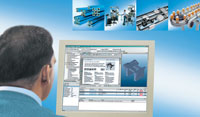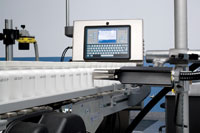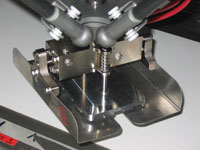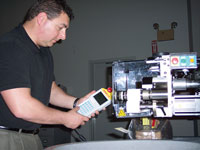
3-D solid models take packaging-line integration to a higher level, though the absence of a dominant model or standardized format can bring design projects to a grinding halt. Source: Bosch Rexroth Corp.
The community of packaging machinery fabricators is encouraging greater collaboration in the design and execution of end-of-line systems. Modular mechanical designs with integrated control hardware and software are being encouraged by the Packaging Machinery Manufacturers Institute (PMMI), for example, but results to date are modest. After seven years, the OMAC Packaging Workgroup has advanced little beyond a machine-state definition. And a loose confederation of machine builders and technology providers called Packaging End-of-Line Solutions (PELS) has made little progress in two years. Still, the effort exemplifies the kind of collaborations many believe are necessary to better integrate the packaging area to deliver the flexibility today’s manufacturers need.
Major beverage companies are attaining packaging-machine integration by installing turnkey systems from a single vendor, argues John Kowal, global marketing manager at Schaumburg, IL-based Elau Inc. An example is Pepsico’s Gatorade plant in Wytheville, VA (“Sustainability with attitude,”Food Engineering, October 2007), where every inch of conveyor and equipment from the fillers to palletizers was built by Krones Inc. That level of integration is only possible in a new facility or new line, of course, and the vast majority of manufacturers have to cope with existing lines and changing products. For those firms, plug-and-play modularity is even more important.
PELS is an attempt to bring smaller firms together to deliver turnkey solutions similar to the Krones project, explains Jarrett Campbell, the Raleigh, NC-based packaging segment manager for Schneider Electric. The French technology firm, which acquired Elau three years ago, believes PELS is consistent with PMMI’s MachinePLUS initiative, which encourages US machine builders to take responsibility beyond their machines and deliver more value through standardized components and simplified controls. “The end-user wants the lowest cost of ownership for the packaging line,” says Campbell, and streamlined integration and simplified maintenance help deliver it.

Whether manufacturers rely on lot numbers or unique product identifiers, item coding is becoming the first line of defense in automated tracking and tracing programs. Source: Videojet Inc.
For now, the concept is more theoretical than applied. Only three builders of cartoning, case packing and wrapping machines are participating in PELS. “It’s a nice, tight group,” Campbell cheerfully says, and while no turnkey projects have been executed, some modest projects have been undertaken.
A less ambitious approach to packaging line design that is hobbled by a fragmented user community is 3-D solid models. “Most manufacturers and their suppliers have transitioned or plan to transition to 3-D solid models from 2-D AutoCad models,” says Kevin Gingerich, marketing director at Bosch Rexroth Corp.’s linear motion group in Buchanan, MI. “The real benefit is in not ordering machines and components that aren’t going to fit in the space available.”
Bosch created MTpro software to help OEMs and end-users export three-dimensional renditions of its packaging conveyors to solid model programs such as SolidWorks and Autodesk Inventor. Unfortunately, unless the suppliers of packaging machines, robotic systems and other components also use agnostic modeling tools, Bosch’s electronic catalogue is of little use to the person designing the line.
Intel’s dominance of the semiconductor industry allowed it to impose standards by decree, Schneider’s Campbell observes. A similar situation existed with 2-D modeling, Gingerich says, where AutoCad was the de facto standard. With multiple 3-D models in use, specifiers are wrestling with file-format issues and losing 2-D functions like ergonomic evaluations of a new component to view the line in three dimensions.

While specialized grippers are being engineered for cuts of meat and other nonstandard product sizes, they add costs that many food processors are unable to justify. Source: Applied Robotics Inc.
From RFID's ashes
One of the most contentious end-of-line issues in the 21st century was RFID, with food and beverage manufacturers hard pressed to make a business case for implementing the post-packaging technology. With Wal-Mart backing away from previously announced RFID mandates because of reliability issues and supplier reluctance to use the technology, RFID seemed more like a passing fad than a shipment-tracking game-changer.But auto ID hasn’t gone away, and some of the issues that retarded RFID are being resolved in other coding and marking and track and trace systems. The use of 2-D codes is expected to mushroom, and it will be helped along by broad acceptance of OPC communications standards that move item-specific information into warehouse and enterprise management systems without prohibitively expensive data integration work.
“RFID is not what our customers want,” says Bob Neagle, manager of Videojet Inc.’s brand protection solutions unit. RFID may yet find a packaging niche, “maybe at the pallet level,” he concedes, but the GS-1 compliant 2-D codes are “where the market is going.”

Cold air and moisture make frozen foods one of the more daunting marking challenges for printed codes. Source: Markem-Imaje.
Dreyer’s Grand Ice Cream Inc. had one of the first 2-D applications in food three years ago when it integrated optical readers on carton-formers at its Bakersfield, CA plant, to verify the right cartons were going to the fillers (“In the groove in Bakersfield,” Food Engineering, April 2006), but that system simply reads a preprinted code. Now manufacturers are beginning to print, verify and read 2-D. The codes, typically smaller than a thumb, contain the equivalent of 24 digits or more of information, bringing item-level tracking within reach.
Markem-Imaje is working with a potato processor that intends to imprint a 2-D code for time stamping and tracing cases of frozen French fries and a second code to direct the activities of robotic palletizers. Customer requirements for rainbow pallets and other special requirements will flow from the ERP system to PLCs on the floor. “We can actually tell the palletizer what needs to be done simply by reading the code,” says Habib.
While tag costs were an issue, data integration also loomed as a major barrier to deriving value from RFID. Middleware had to be written between printers and other devices, and other re-engineering was needed. Fortunately, in recent years Siemens, Rockwell and other controls suppliers have embraced OPC open connectivity. “I can write one standard and don’t have to rewrite code to communicate with all the devices,” says Habib. That paves the way for lower costs and greater benefits from 2-D implementations.

Laser scanners cast a red line on cases as they read codes on cases moving down a conveyor. Arrays of two and four lasers can read codes up to 6 ft. away. Source: Accu-Sort Systems Inc.
Material handling applications are Accu-Sort’s forte. Reliability is almost as much a concern as read rates, and the company is beefing up laser scanners “to ensure longer mean time between failures,” according to Cindy Zeiger, product manager at the Philadelphia firm. IP-65 enclosures and rugged new fans and filters on Accu-Sort’s Axiom laser scanners push mean time to failure to 70,000 hours, about 57% longer than the previous version, she says. At a recent installation at Herr Foods’ Nottingham, PA facility, the units helped boost read rates almost 20% over the previous generation.
Another improvement at Herr was the integration of scanner data with the ERP. “They knew what product went on what truck, but it wasn’t sent to the business system,” says Zeiger. Integration eliminated the need for manual warehouse inventories after each shift, and it was accomplished with minimal recoding.
Food and beverage production has achieved such a high degree of optimization that there is little low-hanging fruit to help rationalize additional investments. Supply chain improvements are today’s focus, and the supply chain of finished goods begins with end-of-line packaging. The technology to improve that operation exists, and the first halting steps in leveraging it are underway.
For more information:
Cindy Zeiger, Accu-Sort Systems Inc., 800-227-2633
Kevin Gingerich, Bosch Rexroth Corp., 269-697-5295, kevin.gingerich@boschrexroth-us.com
John Kowal, Elau Inc., 847-490-4270, john.kowal@elau.com
David Habib, Markem-Imaje, 603-966-8527, dhabib@markem-imaje.com
W. Jarrett Campbell, Schneider Electric, 919-855-1139, jarrett.campbell@us.schneider-electric.com
Joyce Witt, Unique Solutions, 847-540-1200, info@unique-solutions.com
Bob Neagle, Videojet Technologies Inc., 630-860-7300

A wrapped coupon is ejected as Rocco Morisco of Unique Solutions demonstrates the firm’s insert machine for flat items and pouches. The system usually is placed immediately before or after a filler.
Cracker jack package-insert system
Since its inception in 1893, Cracker Jack has been a pioneer in mass produced snacks, and 19 years later, it was on its way to becoming an American icon when a prize was inserted in each box. Despite its production moxie-developing a way to keep caramel popcorn and peanuts from agglomerating was a closely held secret for years-Cracker Jack’s first owners relied on people to insert the prizes.Frito-Lay acquired Cracker Jack in 1997, and it doesn’t count on people to insert the printed jokes and game cards that have replaced plastic toys. The Dallas snack food giant was the first customer of Unique Solutions, the Lake Zurich, IL maker of high-speed insertion machines to support the in-pack and on-pack promotions of its parent company, Unique Coupons Inc. The reliability and versatility of the machines resulted in an accelerated deployment of 450 units at Frito-Lay in the early 1990s, recalls Joyce Witt, Unique’s chairman and CEO.
Unique’s compact inserters typically are positioned immediately before or after a filler, depending on where the manufacturer wants the item relative to the product. Inserts usually are overwrapped in cellophane and strung together in a perforated bandolier. A sensor detects the leading edge of the primary package as it approaches, and one item is shot into the box at speeds of up to 1,000 inserts per minute.
Staff engineers have continuously refined the machine’s design, migrating from a clutch and break assembly to stepper motors and finally a dual-servo design that can handle both flat items and pouches up to 2 inches thick. The newest system’s control box is 30% more compact than the first generation, and the machine is 25% smaller, says Witt, with 70 fewer parts than the previous design. Fill rates are significantly higher than pick-and-place systems, she adds, and the unit’s compact design and cost are lower than bowl feeders, which are prone to jams if a pouch is doubled up.
Despite those advantages, Unique has not cracked some of the emerging insert markets, such as bagged salads with dressing and crouton packets. As with any technology, manufacturers are reluctant to switch from a method that works most of the time to something new.
